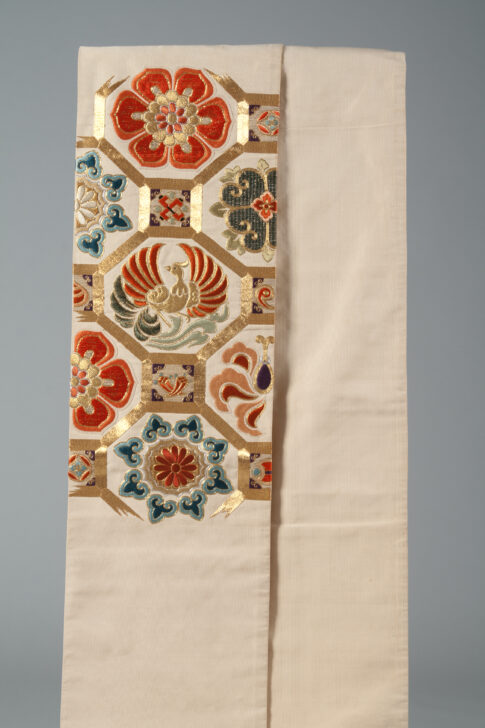Obi
Japanese

Description
Subject Matter:
This is a Nishiji, Nishiki, and Fukuro Obi, in Otaiko gara
The Shokkou (octagonal and square motif) patterns are Shu Brocade motifs, inspired by third-century brocades from the Chinese kingdom of Shu, and introduced to Japan during the Muromachi period (1338-1573). Inside one of these shapes are a Phoenix, an imaginary Chinese bird that was believed to appear on happy occasions. This bird of good fortune would fly to the imperial palace on the most auspicious of occasions. The Chinese stylized flowers, sacred scrolls, and clove motifs , created during the Tang Dynasty in China, arrived in Japan with Buddhism during the Nara period 9710-794).
This Obi is most likely a Kara Textile which is in the same family of Nishijin Textile. The Kara Textile was introduced from China during the Muromachi Period (1336-1573), and gives brocade an impression that the raised interwoven motifs are embroidered. Nishiki is a type of vibrant silk brocade with vivid and luxurious images using various colorful and metallic (mainly gold and silver). Nishiki brocade is mainly produced in the Nishijin area of Kyoto. Fukuro Obi is double-layered single sided obi in which two separately woven surfaces and back pieces of cloth are stitched together. This type of obi is typically only worn at weddings or other formal occasions. Gara refers to the orientation, arrangement, and surface area of the patterns and pertains to a specific trend and obi tying style. The patterning in the Otaiko gara type is minimal. A few concentrated spots of patterned motif lie on the obi while the rest is left blank. This style was invented during the Edo period (1615-1868) by the female entertainers in Fukugawa, an entertainment district in present-day Tokyo.
Physical Description:
Light beige Fukuro (single sided) obi with gold brocade featuring geometric, floral, and animal motifs.
Usage Rights:
If you are interested in using an image for a publication, please visit https://umma.umich.edu/request-image/ for more information and to fill out the online Image Rights and Reproductions Request Form.